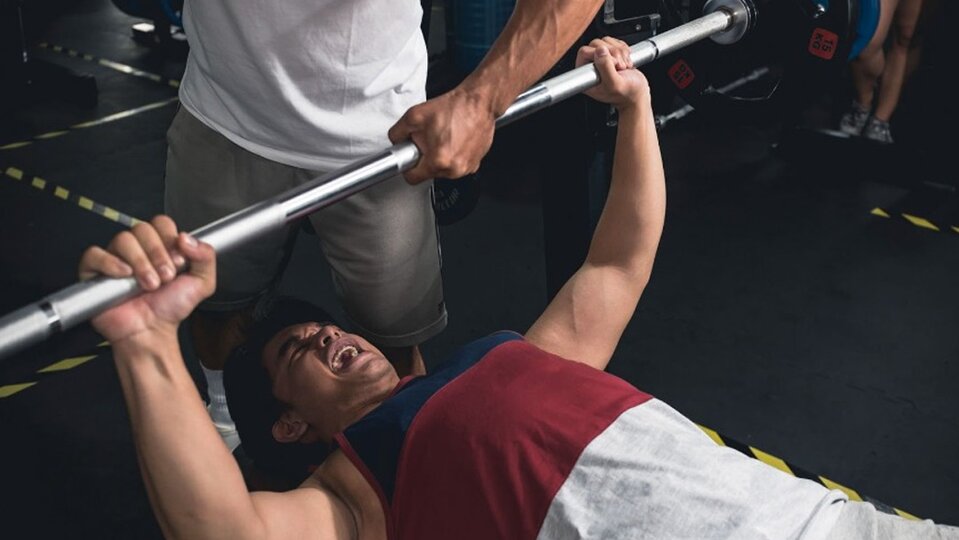Being a spotter is bound to happen sometime during your workouts. Whether you’re spotting a workout partner or if someone asks you for help in a commercial gym, you’re going to need to be ready to assist. Spotting is a crucial role for keeping other athletes safe and for helping them get the most out of their workouts. Learn how to use proper spotting techniques on some of the more common spotting exercises below.
Bench Press
Now the bench is the most common exercise to ask for a spot during. This is mainly due to how easy it is to fail a rep. Unlike exercises such as the deadlift, where if you can’t complete a rep, you can just set the weight down, a barbell will get stuck on top of your chest if not finished. This is where a spotter comes in. It’s their job to help keep the weight moving.
In order to spot with proper form, it is first important to know when to stand back. Always be on the ready, but don’t interfere with the exerciser’s reps if they’ve got it. Allow them to work out, and only begin to intervene when they’re showing signs of fatigue. Once their bar path is slowing down, it’s time to get to work. Have one leg near the bench, and the other back and to the side. Having this stance will allow you to pull with the most leverage while not getting in their way. Next, hold your hands in an over-under grip (one hand overhand, one hand underhand) near the bar. Follow the bar with your hands as they raise and lower it. Only touch the bar if the rep really starts to slow down or if they fail the rep. When they reach their sticking point, firmly grasp the bar, and pull the bar up. Remember to still let them do most of the work, since they’re trying to build muscle. Your job is just to make the impossible reps possible, forced reps if you will.
Dumbbell Press
Now despite being nearly identical exercises, benching with dumbbells changes up the game. Unlike the barbell bench, you can’t get stuck at the bottom. If the lifter fails a rep, they can just let go of the dumbbells safely. Because of this, the main priority of the spotter on this exercise is on creating stability.
The first time you’ll become involved as the spotter is in the setup. When the lifter is leaning back on the bench, they’ll need to bring the dumbbells to the top position. Doing this first rep is often the hardest part of the lift, especially if they’re using heavier weight. To help them safely get into the starting position, you’ll want to squat down behind them and place your hands around their elbows. From there, firmly push on their elbows to bring them to the top. Once they’re ready to begin, watch from behind for signs of fatigue as they go through their reps. Once they start to slow down, do the same thing as before. Push up on their elbows only as much as they need you to, and watch out for any breaks in their form. Keep them safe, and help them get as many reps as possible to maximize muscle growth.
Squat
Squats are another compound lift in which the lifter will be under some real heavy weight. The first rule of spotting on the squat is actually not about the spotter at all. Most squat racks come with safety bars on them. They’re there to catch the bar in case of a total collapse in form. Even if you’re the best, strongest spotter there is, it is still a great idea to set these up.
Once those are in place and adjusted to the correct height, it’s time to begin the lift. As the spotter, you want to stand behind the lifter. Like before, you’re waiting to get involved only when they start to fatigue, while also being ready to quickly intervene if there are any breaks in form. When it’s your time to help, walk up right behind the lifter. Follow them down in a squat of your own, and have your arms ready to catch them. If they need your help, wrap your arms around their core or beneath their armpits, and help them stand up. It’s paramount to keep their core upright as they’re going. If for whatever reason, their core can’t hold their torso stable, it’s safer to help lower the weight onto the safety bars you set up.
Key Spotting Principles
When it comes to giving a good spot, it’s all about safety and efficiency. You’re there to help prevent any injuries and to make sure your training partner gets the most out of their workout. So pay attention, and don’t be stealing reps. With that in mind, go out there and fulfill your weightlifting duty in the gym by becoming the best spotter you can be. And don’t be afraid to ask for a spot yourself when you need it. Anyone can use a little help when working with free weights.

